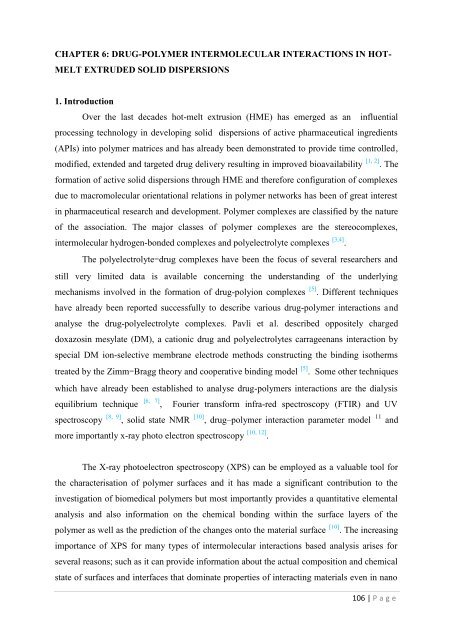Development of hot-melt extrusion as a novel technique for the ...
Development of hot-melt extrusion as a novel technique for the ...
Development of hot-melt extrusion as a novel technique for the ...
Create successful ePaper yourself
Turn your PDF publications into a flip-book with our unique Google optimized e-Paper software.
CHAPTER 6: DRUG-POLYMER INTERMOLECULAR INTERACTIONS IN HOT-MELT EXTRUDED SOLID DISPERSIONS1. IntroductionOver <strong>the</strong> l<strong>as</strong>t decades <strong>hot</strong>-<strong>melt</strong> <strong>extrusion</strong> (HME) h<strong>as</strong> emerged <strong>as</strong> an influentialprocessing technology in developing solid dispersions <strong>of</strong> active pharmaceutical ingredients(APIs) into polymer matrices and h<strong>as</strong> already been demonstrated to provide time controlled,modified, extended and targeted drug delivery resulting in improved bioavailability [1, 2] . The<strong>for</strong>mation <strong>of</strong> active solid dispersions through HME and <strong>the</strong>re<strong>for</strong>e configuration <strong>of</strong> complexesdue to macromolecular orientational relations in polymer networks h<strong>as</strong> been <strong>of</strong> great interestin pharmaceutical research and development. Polymer complexes are cl<strong>as</strong>sified by <strong>the</strong> nature<strong>of</strong> <strong>the</strong> <strong>as</strong>sociation. The major cl<strong>as</strong>ses <strong>of</strong> polymer complexes are <strong>the</strong> stereocomplexes,intermolecular hydrogen-bonded complexes and polyelectrolyte complexes [3,4] .The polyelectrolytedrug complexes have been <strong>the</strong> focus <strong>of</strong> several researchers andstill very limited data is available concerning <strong>the</strong> understanding <strong>of</strong> <strong>the</strong> underlyingmechanisms involved in <strong>the</strong> <strong>for</strong>mation <strong>of</strong> drug-polyion complexes [5] . Different <strong>technique</strong>shave already been reported successfully to describe various drug-polymer interactions andanalyse <strong>the</strong> drug-polyelectrolyte complexes. Pavli et al. described oppositely chargeddoxazosin mesylate (DM), a cationic drug and polyelectrolytes carrageenans interaction byspecial DM ion-selective membrane electrode methods constructing <strong>the</strong> binding iso<strong>the</strong>rmstreated by <strong>the</strong> ZimmBragg <strong>the</strong>ory and cooperative binding model [5] . Some o<strong>the</strong>r <strong>technique</strong>swhich have already been established to analyse drug-polymers interactions are <strong>the</strong> dialysisequilibrium <strong>technique</strong> [6, 7] , Fourier trans<strong>for</strong>m infra-red spectroscopy (FTIR) and UVspectroscopy [8, 9] , solid state NMR [10] , drug–polymer interaction parameter model 11 andmore importantly x-ray p<strong>hot</strong>o electron spectroscopy [10, 12] .The X-ray p<strong>hot</strong>oelectron spectroscopy (XPS) can be employed <strong>as</strong> a valuable tool <strong>for</strong><strong>the</strong> characterisation <strong>of</strong> polymer surfaces and it h<strong>as</strong> made a significant contribution to <strong>the</strong>investigation <strong>of</strong> biomedical polymers but most importantly provides a quantitative elementalanalysis and also in<strong>for</strong>mation on <strong>the</strong> chemical bonding within <strong>the</strong> surface layers <strong>of</strong> <strong>the</strong>polymer <strong>as</strong> well <strong>as</strong> <strong>the</strong> prediction <strong>of</strong> <strong>the</strong> changes onto <strong>the</strong> material surface [10] . The incre<strong>as</strong>ingimportance <strong>of</strong> XPS <strong>for</strong> many types <strong>of</strong> intermolecular interactions b<strong>as</strong>ed analysis arises <strong>for</strong>several re<strong>as</strong>ons; such <strong>as</strong> it can provide in<strong>for</strong>mation about <strong>the</strong> actual composition and chemicalstate <strong>of</strong> surfaces and interfaces that dominate properties <strong>of</strong> interacting materials even in nano106 | P a g e
















